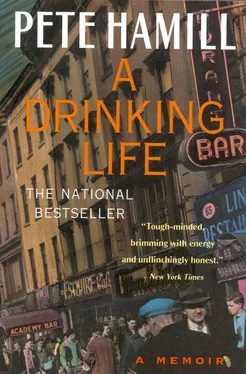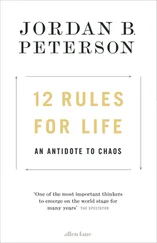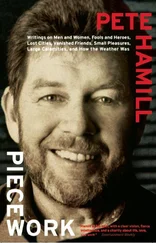But I didn’t just want to draw the characters the way Caniff did. I didn’t really want to have his studio in New City. The truth was that I wanted to live the way his creations lived. I didn’t want to spend a lifetime doing a comic strip about husbands and wives, or the distant past, or funny animals. I wanted to see the exotic places of the world. I wanted to go where my grandfather had gone. In a notebook, I copied a sentence from Waugh’s book that described Roy Crane’s creations: In the old days tubby Tubbs and lanky Easy were loose-footed soldiers of fortune, a big and little stone rolling through the romantic places of the earth, usually broke, sometimes fabulously wealthy, but always ready for fight, frolic, or feed.
That was it. To be a rolling stone. In the romantic places of the earth. Ready for a fight, a frolic, or a feed. And since I was Irish, since I was Billy Hamill’s son, since I was from Brooklyn: a drink too.
AROUND THE SAME time, a sign painter named Jim Brady opened a shop on Seventh Avenue off the corner of Thirteenth Street, just past the swirling pole of Fortunato’s barbershop, where my father got his hair cut. One summer morning I walked past the shop and stopped short. In the window was an enlarged photostat of the first Terry daily, drawn by Caniff in a much more cartoony style than the richly brushed strip that had become my obsession. There were also mounted photostats of characters from Terry and some Terry comic books arranged in a display. The shop was closed. But I came back that evening and saw a heavy-set man with reddish hair working on a sign for a butcher. He had a red handkerchief tied across his brow to prevent his sweat from splashing on the posters. His eyes were hidden behind thick horn-rimmed glasses. He only had one hand, and held a paintpot in the crook of the injured right arm. He must have felt my eyes on him.
Can I help you, kid? he said.
Uh, I — Well, I saw the Milton Caniff drawings in the window.
He paused.
You a Caniff fan?
Yeah.
Come on in.
He let me watch as he worked on the sign, and asked me questions. Did I draw every day? Was there a drawing class in my school? Where did I live? Oh, so you’re Billy Hamill’s kid. Hell of a guy, your dad. What do you do after school? Well, maybe you could work for me. Sweep the store. Deliver the signs… But I can’t pay much, kid.
So began my apprenticeship. I came back every day. And in that hot, narrow shop, smoky from Brady’s Pall Malls, with beautifully lettered signs for pork chops and clamb roasts appearing in black and red paint on rolls of poster paper that unfurled across a tilted plywood worktable, Brady told me tales of the world of comics. Before he became a sign painter, he explained, he was a professional letterer for comic books. That is, he was part of that mysterious and powerful world across the river in Manhattan, where they did the work that I loved so much. He showed me his collection of originals, by Alex Toth (He’s the best around and he’s only a kid.) and a man named Edmund Good (who worked for a time as the artist on Scorchy Smith) and some other artists whose names I no longer remember. These were oversized two-ply Strathmore pages in black and white, the blacks very black, with corrections made in china white. Brady explained how in comic books, one man wrote the script, another penciled all the panels (Usually with a pale blue pencil, ‘cause that blue don’t photograph when they reduce the page to comic book size), another inked the pencil drawings, and another, the letterer, did all the balloons. Caniff himself used a fabulous letterer named Frank Engli: A great cartoonist in his own right, ya know, but a master letterer. Brady said he loved doing lettering for comic books. But my eyes started going so I had to stop… He shook his head sadly, then removed his thick glasses and rubbed his eyes with the elbow of the bad arm. He didn’t explain what had happened to his hand, and I didn’t ask. But I felt pity for him; like my father, he had lost part of himself on the way to Seventh Avenue in Brooklyn.
Sometimes I brought him the latest old Terry comics I had discovered in the bookstores. He would look at them and point out what Caniff was doing.
You see, it’s like a movie, like a frozen movie, he said. Long shot, medium shot, closeup — see what I mean?
I said I did (and when I went to the movies, I started seeing Caniff in everything). Brady explained about lettering: thick verticals, thin horizontals. If you have a lettering pen, the nib does it, but ya gotta do it over and over again to make it look natural. He explained the difference between serif and sans serif. He showed me how Roy Crane and Will Eisner (in The Spirit comic books) used lettering to create sounds: Ka-BONG, Padda-pow!
Ya gotta draw and draw, he said, and when you’re old enough, ya gotta go to art school.
In a way, that was exactly what I was doing in Jim Brady’s shop. His art school even had a small library: old comics, books on drawing and lettering. One day, in a cardboard box, I discovered a book of cartoons by Caniff that I’d never seen before. He had drawn them every week for Stars and Stripes, and they weren’t meant for civilians. Or for kids. The strip was called Male Call, and it featured the most arousing woman of my young life: Miss Lace. She was dark-haired, sloe-eyed, with a lush body that seemed to struggle for release from her clothing. Lace was sexy, funny, generous; it wasn’t clear what she was doing in the various theaters of operations but she was certainly making the fighting men happy. Lace reminded me of Rita Hayworth (or, more precisely, the sultry Rita Hayworth provoked in me even more lavish images of Miss Lace), and whenever Brady left me alone in the shop I took out the book and stared at Miss Lace and her hair, mouth, teeth, breasts, and hips in an agony of desire. She didn’t exist anywhere in the world, and I didn’t care.
Then one afternoon I came into the shop and Brady didn’t seem to know me.
What the fuck do you want?
I didn’t know what to say. And then I realized he was drunk. He was trying to letter an O. But he couldn’t hold the curve. He stopped, took the brush in his teeth, and furiously crumpled the paper.
Goddammit, he said, goddammit, goddammit.
I backed up quietly and slipped out into the night. I felt like crying, but couldn’t; everybody on the street would see me. I walked in a blur to Prospect Park and back, thinking: They’re all drunks. All of them. Every last one.
IN THE YEARS after the war, I stopped worrying about my father. He was there, all right, and I talked to him about baseball, or boxing, or the weather. But it was as if I understood that I would never get from him what I wanted most: the kind of casual affection that is a sign of love. I protected myself with indifference, dreams of substitute worlds, a belief in a limitless future that didn’t depend upon him. I certainly never talked to him about Jim Brady’s sign store, or cartooning, or art school. I knew better.
Instead, I moved back and forth from the street to the Little Room (where Tommy and I now shared bunk beds), from stickball and fistfights to blue pencils, Higgins ink, and the mysteries of the crow quill pen. This wasn’t easy. Suddenly, down in the street, it was the time of the gangs.
The street gangs were all over New York then, and the newspapers wrote about them every other day. In Brooklyn, there were immense black gangs in Bedford-Stuyvesant called the Bishops and the Robins; the Navy Street Boys from the waterfront in Fort Greene; tough Jewish gangs from Brownsville and Coney Island. And there were street gangs right in the Neighborhood.
Читать дальше












